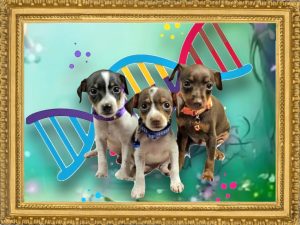Cystinuria
This is an inherited disease affecting kidney function in dogs. The SLC7A9 gene codes for a protein that allows the kidneys to transport cysteine and other amino acids from the urine. Normal kidneys reabsorb cystine so that only small amounts pass into the urine, while dogs with mutations of both copies of the SLC7A9 gene fail to reabsorb cystine allowing high amounts to pass into the urine, hence the name cystinuria. Cystine can form crystals and/or stones in the urinary tract which can block the ureters or uretha and stop the normal flow of urine. Affected male dogs present with symptoms related to cysteine bladder stones around one year of age, however female dogs tend to develop symptoms later than males. Symptoms of disease include straining to urinate, frequent urination of small volumes or inability to urinate. In miniature pinschers, males and females are equally affected with excess cysteine in the urine, but obstruction of urine flow is more common in males due to differences in anatomy. Dogs with cystinuria often have recurrent inflammation of the urinary tract and if not treated, urinary stones can cause urinary tract infections, kidney failure and even death.
Hyperuricosuria
Dogs with variations in both copies of the SLC2A9 gene(variant) are predisposed to have elevated levels of uric acid in the urine, hence the name hyperuricosuria. Uric acid can form crystals and/or stones (uroliths) in the urinary tract. Dogs with hyperuricosuria most commonly present with symptoms of recurrent urinary tract inflammation, which include frequent urination, blood in the urine, and straining to urinate. They may also have loss of appetite, lethargy, weakness, vomiting and pain. Urinary stones in the bladder can cause urinary tract infections or more seriously, blockage of the Urethra. Both male and female dogs can be affected, but obstruction of urine flow is more common in males due to differences in anatomy.
Degenerative myelopathy (DM)
DM is known well in the German Shepherd Dog, although other breeds are also predisposed. This disease is normally seen around middle age, and in general diagnosis can only be confirmed at post mortem examination. Breed surveys of some predisposed breeds indicate a fairly low occurrence rate, but most experts think this rate is actually much higher, due to the lack of post mortem follow up of the majority of suspected cases. Signs are due to the immune-mediated destruction of a part of the nerves in the spinal cord, leading to loss of these nerve fibres. The first sign is knuckling of the hind feet, and hind limb ataxia. Once the spinal cord damage progresses past this initial stage (termed proprioceptive deficits), the effectiveness (if any) of treatment is much diminished. Hence early diagnosis is vital. Following this initial stage, hind limb reflexes are affected, then weakness in the hind limbs develops, progressing to total paralysis. Once a dog shows these signs it will almost always respond poorly to therapy. Eventually destruction progresses from the middle of the spinal cord to the upper cord and brain stem, leading to forelimb weakness and eventually interference with the muscles of breathing, causing death. Most dogs are euthanased for humane reasons before this happens. Treatment is with specific supplements and drugs aimed at interfering with the immune destruction in the spinal cord, to slow further nerve damage. The effectiveness of this treatment is variable, but is only of benefit if started as early as possible. Once nerves are lost, they will not be replaced. Degenerative myelopathy cannot be cured. A DNA test is available for predisposed pure breeds to carry out screening of breeding animals.
IVDD in dogs is defined by dysplastic, shortened long bones and premature degeneration and calcification of intervertebral discs. This disease is therefore much more common in the chondrodystrophic breeds (that is short-legged breeds such as the dachshund, basset hound and corgi) and the dachshund accounts for 45 – 70% of all intervertebral disc disease (IVDD) in dogs. Chondrodystrophic breeds are prone to a type of disc degeneration called chondroid metaplasia, where the intervertebral discs in the spinal column become dried out, hardened and calcified at an early age. The discs are then less able to flex with movement, and more prone to bulging or rupture. The calcified inner disc material puts pressure on the spinal cord, causing pain and damage to the nerves running through the spinal cord. Severe pain to paralysis can occur, as well as inability to urinate or defaecate, and disc ruptures in the neck can cause respiratory paralysis and death. Signs of intervertebral disc rupture most commonly occur in chondrodystrophic breeds between 3-6 years of age. Calcification of discs is generally apparent on x-rays by 2 years. Ruptures can occur anywhere, but are more common in the upper back (65%), followed by the neck area (18%). IVDD can occur in non-chondrodystrophic breeds as well, with the most commonly affected being German shepherd dogs, Labrador retrievers and Dobermanns. In these breeds disc rupture tends to occur later, at around 8 years of age on average. Obesity is also a major risk factor for IVDD. Disc rupture is generally suspected from clinical signs of severe pain or neurologic deficits, and is confirmed via myelography (injecting dye into the spinal canal which is then visible on x-ray) or MRI. Plain x-rays are not diagnostic for disc rupture, however they may rule out other conditions. In less severe cases treatment may be successful with medication, nursing and strict cage rest for a number of weeks. With significant nerve deficits or any ongoing deterioration, surgical removal of the prolapsed disc is the treatment of choice. Recovery from surgery involves physiotherapy and good pain management, and if treated early the prognosis for IVDD is generally good.
***Though this disorder is rare in the Miniature Pinscher. This disorder is associated with the breed due to having Dachshund in their ancestry. We have taken the stand to test for it in our adult dogs.
Black hair follicular dysplasia (BHFD)
BHFD is inherited as an autosomal recessive trait and is a type of alopecia (hair loss) that only affects areas of black fur. It is seen in bicolor and tricolor dogs. Pups are born normally, but may show a dulling of the normal dark, glossy black hair. The hair on adjacent white skin grows normally. With time black hairs become brittle and break easily. Black hair fails to grow, and skin can become scaly. It is thought that BHFD may be related to the condition “colour dilution alopecia”, in which hair loss is seen in color dilute animals (e.g. blue and fawn dogs). Both conditions seem to involve defects in the processing and transport of the skin and hair pigment melanin. With BHFD, the hair follicles in areas of black hair are abnormal, with clumps of melanin, distorted follicles and hyperkeratosis seen on histopathology. These abnormal hair follicles are prone to infection, and so affected areas of skin can develop bacterial folliculitis, an infection that is very irritating and can sometimes lead to deeper skin infection (pyoderma). Treatment is symptomatic only, and abnormal or missing hairs will not be replaced by normal hairs. Topical antiseptics or antibiotics are used for bacterial folliculitis. Antiseborrhoeic shampoos and oil rinses are often helpful, and general skin treatments such as omega fatty acids are often given. Other treatments recently reported of possible benefit include melatonin, etretinate (a synthetic aromatic retinoid) and niacinamide. Affected animals should not be used for breeding. Several breeds now have a DNA test available to them for screening prior to breeding.
Color Dilute Alopecia (CDA)
This condition is seen in dogs with a dilute colored coat and occurs in up to 90% of blue Dobermanns, and 75% of fawns. This condition also occurs in other breeds where breeding for colour dilute individuals occurs, although it does not tend to be seen at such high rates as in the Dobermann, and prevalence rates can vary depending on the breed. Colour dilute Weimeraners do not seem to be affected at all. The reason for the amount of variation between colour dilute animals of different breeds is not known. The main breeds affected (other than the Dobermann) include the Boston terrier, the Chihuahua (blue), Great Dane (blue), Dachshund (blue), Miniature Schnauzer, Miniature Pinscher (blue), Shetland Sheepdog (blue), Whippet (blue), Standard Poodle (blue), Yorkshire Terrier (grey/blue), Irish Setter (fawn) and the Bernese Mountain Dog. Colour dilution alopecia is a type of follicular dysplasia, and only occurs when colour dilution is present. A blue coloured animal is the colour dilute form of the normal black and tan colouration, and fawn is the colour dilute form of the normal red colouration. It is thought that there is a defect in the regulation of melanisation (pigmentation) and the structure of the hair cortex, although the underlying genetic defect is not fully understood. Affected animals are born with normal hair coats, but usually signs will be seen between 6 months and 2 years of age, when the hair will begin to break, and patchy alopecia (hair loss) occurs. This usually starts on the back, and will progress to widespread hair loss wherever there is light coloured hair. The skin becomes dry and scaly, and is prone to infections. Hair that is lost will not grow back. Affected dogs are also susceptible to sunburn and cold. There is no cure for this condition. Diagnosis is confirmed with skin biopsy, which will show characteristic changes when assessed by an experienced veterinary dermatopathologist. Treatment is symptomatic, using antiseborrhoeic shampoos and oil rinses, moisturisers and antibiotic therapy or antiseptics for secondary infections.


 We proudly use the Orivet Genetic lab for the testing and DNA parental verifications of all of our dogs. We also use the Embark lab for breed percentages an coefficient of inbreeding (COI) to keep our program going in the right direction. “TO BETTER THE BREED”.
We proudly use the Orivet Genetic lab for the testing and DNA parental verifications of all of our dogs. We also use the Embark lab for breed percentages an coefficient of inbreeding (COI) to keep our program going in the right direction. “TO BETTER THE BREED”.